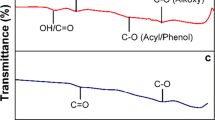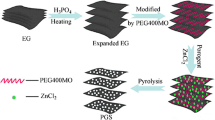Abstract
Graphene-based negative electrodes in lithium-ion batteries have recently been the focus of interest. In this study, sulfur (S)–doped graphene powders in different functionality have been prepared in one step by using Yucel’s method for the first time in the literature and they have been used as anode materials of Li-ion batteries. By changing the scanned potential during the preparation of S-doped graphene powders, the graphenic surface is covalently doped by –C-S-C- and –C-SOx-C- (x:2, 3) groups at different amount. When the potential has been scanned in wider potential range (− 1.0 and 2.5 V), 48 sp2-hybridized carbon rings have been determined on the powders by using Raman analysis. It is the lowest as 16 for graphenic powder prepared at narrower potential range (1.5 and 2.5 V) and chronoamperometric method. S-doped graphene powders have been investigated by microscopic methods. Electrochemical properties of the prepared S-doped graphene powders and their potential use in Li-ion batteries have been assessed. At a 50-mA/g current density, the 915-mAh/g specific capacity has been determined as the highest discharge capacity in the powder which was prepared by the chronoamperometric method. Specific capacities of 710 mAh/g, 594 mAh/g, and 642 mAh/g have been observed in the powders prepared between − 1.0–(+ 2.5 V), 0.6–(+ 2.5 V), and 1.5–(+ 2.5 V) samples, respectively.









Similar content being viewed by others
References
Nitta N, Wu F, Lee JT, Yushin G (2015) Li-ion battery materials: present and future. Mater Today 18:252–264
Peters JF, Baumann M, Zimmermann B, Braun J, Weil M (2017) The environmental impact of Li-ion batteries and the role of key parameters – a review. Renew Sust Energ Rev 67:491–506
Dönmez KB, Gençten M, Şahin Y (2017) A novel polysiloxane-based polymer as a gel agent for gel–VRLA batteries. Ionics 23:2077–2089
Dönmez KB, Gençten M, Sahin Y (2018) A performance comparison of protective silicate-coated lead and non-coated lead electrodes in various kind electrolytes of gel valve-regulated lead-acid battery. Ionics 24:3655–3664
Arvas MB, Gencten M, Sahin Y (2019) A two-dimensional material for high capacity supercapacitors: S-doped graphene. Int J Energy Res 44:1624–1635
Kocyigit N, Gencten M, Sahin M, Sahin Y (2020) A novel vanadium/cobalt redox couple in aqueous acidic solution for redox flow batteries. Int J Energy Res 44:411–424
Yoshio M, Brodd RJ, Kozawa A (2009) Lithium-ion batteries: science and technologies. Springer, New York
Wakihara M, Yamamoto O (2008) Lithium ion batteries: fundamentals and performance. John Wiley & Sons, Weinheim
Li H, Wang Z, Chen L, Huang X (2009) Research on advanced materials for Li-ion batteries. Adv Mater 21:4593–4607
van Schalkwijk W, Scrosati B (2002) Advances in lithium ion batteries introduction. Springer, Boston
Zhang WJ (2011) A review of the electrochemical performance of alloy anodes for lithium-ion batteries. J Power Sources 196:13–24
Li H, Shi L, Wang Q, Chen L, Huang X (2002) Nano-alloy anode for lithium ion batteries. Solid State Ionics 48:247–258
Aifantis KE, Hackney SA, Kumar RV (2010) High energy density lithium batteries: materials, engineering, applications. John Wiley & Sons, Weinheim
Goriparti S, Miele E, De Angelis F, Di Fabrizio E, Proietti Zaccaria R, Capiglia C (2014) Review on recent progress of nanostructured anode materials for Li-ion batteries. J Power Sources 257:421–443
Liu Y, Xue JS, Zheng T, Dahn JR (1996) Mechanism of lithium insertion in hard carbons prepared by pyrolysis of epoxy resins. Carbon 34:193–200
Liang M, Zhi L (2009) Graphene-based electrode materials for rechargeable lithium batteries. J Mater Chem 19:5871–5878
Pan D, Wang S, Zhao B, Wu M, Zhang H, Wang Y, Jiao Z (2009) Li storage properties of disordered graphene nanosheets. Chem Mater 21:3136–3142
Bai LZ, Zhao DL, Zhang TM, Xie WG, Zhang JM, Shen ZM (2013) A comparative study of electrochemical performance of graphene sheets, expanded graphite and natural graphite as anode materials for lithium-ion batteries. Electrochim Acta 107:555–561
Li X, Hu Y, Liu J, Lushington A, Li R, Sun X (2013) Structurally tailored graphene nanosheets as lithium ion battery anodes: an insight to yield exceptionally high lithium storage performance. Nanoscale 5:12607–12615
Zhang J, Yang Z, Qiu J, Lee HW (2016) Design and synthesis of nitrogen and sulfur co-doped porous carbon: via two-dimensional interlayer confinement for a high-performance anode material for lithium-ion batteries. J Mater Chem A 4:5802–5809
Ou J, Yang L, Zhang Z, Xi X (2016) Honeysuckle-derived hierarchical porous nitrogen, sulfur, dual-doped carbon for ultra-high rate lithium ion battery anodes. J Power Sources 333:193–202
Islam MM, Subramaniyam CM, Akhter T, Faisal SN, Minett AI, Liu HK, Konstantinov K, Dou SX (2017) Three dimensional cellular architecture of sulfur doped graphene: self-standing electrode for flexible supercapacitors, lithium ion and sodium ion batteries. J Mater Chem A 5:5290–5302
Ma X, Ning G, Qi C, Xu C, Gao J (2014) Phosphorus and nitrogen dual-doped few-layered porous graphene: a high-performance anode material for lithium-ion batteries. ACS Appl Mater Interfaces 6:14415–14422
Hassoun J, Bonaccorso F, Agostini M, Angelucci M, Betti MG, Cingolani R et al (2014) An advanced lithium-ion battery based on a graphene anode and a lithium iron phosphate cathode. Nano Lett 14:4901–4906
Soo Yun Y, Jin HJ (2017) Sulfur-doped, reduced graphene oxide nanoribbons for sodium-ion batteries. Mater Lett 14:4901–4906
Yun YS, Le VD, Kim H, Chang SJ, Baek SJ, Park S et al (2014) Effects of sulfur doping on graphene-based nanosheets for use as anode materials in lithium-ion batteries. J Power Sources 262:79–85
Ning G, Ma X, Zhu X, Cao Y, Sun Y, Qi C, Fan Z, Li Y, Zhang X, Lan X, Gao J (2014) Enhancing the Li storage capacity and initial coulombic efficiency for porous carbons by sulfur doping. ACS Appl Mater Interfaces 6:15950–15958
Ma X, Ning G, Kan Y, Ma Y, Qi C, Chen B, Li Y, Lan X, Gao J (2014) Synthesis of S-doped mesoporous carbon fibres with ultrahigh S concentration and their application as high performance electrodes in supercapacitors. Electrochim Acta 150:108–113
Li H, Su Y, Sun W, Wang Y (2016) Carbon nanotubes rooted in porous ternary metal sulfide@N/S-doped carbon dodecahedron: bimetal-organic-frameworks derivation and electrochemical application for high-capacity and long-life lithium-ion batteries. Adv Funct Mater 26:8345–8353
Gao H, Liu Z, Song L, Guo W, Gao W, Ci L, Rao A, Quan W, Vajtai R, Ajayan PM (2012) Synthesis of S-doped graphene by liquid precursor. Nanotechnology 23:275605
Ma X, Ning G, Sun Y, Pu Y, Gao J (2014) High capacity Li storage in sulfur and nitrogen dual-doped graphene networks. Carbon 79:310–320
Ito Y, Cong W, Fujita T, Tang Z, Chen M (2015) High catalytic activity of nitrogen and sulfur co-doped nanoporous graphene in the hydrogen evolution reaction. Angew Chem Int Ed 54:2131–2136
Ma X, Song X, Ning G, Hou L, Kan Y, Xiao Z, Li W, Ma G, Gao J, Li Y (2017) S-doped porous graphene microspheres with individual robust red-blood-cell-like microarchitecture for capacitive energy storage. Ind Eng Chem Res 56:9524–9532
Park J, Jang YJ, Kim YJ, Song M, Yoon S, Kim DH, Kim SJ (2014) Sulfur-doped graphene as a potential alternative metal-free electrocatalyst and Pt-catalyst supporting material for oxygen reduction reaction. Phys Chem Chem Phys 16:103–109
Poh HL, Šimek P, Sofer Z, Pumera M (2013) Sulfur-doped graphene via thermal exfoliation of graphite oxide in H 2S, SO2, or CS2 gas. ACS Nano 7:5262–5272
Gursu H, Gencten M, Sahin Y (2018) Preparation of sulphur-doped graphene-based electrodes by cyclic voltammetry: a potential application for vanadium redox flow battery. Int J Electrochem Sci 13:875–885
Gürsu H, Güner Y, Dermenci KB, Gençten M, Buluç AF, Savacı U, Turan S, Şahin Y (2019) Preparation of N-doped graphene powders by cyclic voltammetry and a potential application of them: anode materials of Li-ion batteries. Int J Energy Res 43:5346–5354
Gürsu H, Gençten M, Şahin Y (2017) One-step electrochemical preparation of graphene-coated pencil graphite electrodes by cyclic voltammetry and their application in vanadium redox batteries. Electrochim Acta 243:239–249
Gürsu H, Gençten M, Şahin Y (2018) Cyclic voltammetric preparation of graphene-coated electrodes for positive electrode materials of vanadium redox flow battery. Ionics (Kiel) 24:3641–3654
Gursu H, Gençten M, Sahin Y (2018) Novel chlorine doped graphene electrodes for positive electrodes of a vanadium redox flow battery. Int J Energy Res 42:3303–3314
Gencten M, Gursu H, Sahin Y (2017) Effect of Α- and Γ-alumina on the precipitation of positive electrolyte in vanadium redox battery. Int J Hydrog Energy 42:25598–25607
Lünsdorf NK, Dunkl I, Schmidt BC, Rantitsch G, von Eynatten H (2014) Towards a higher comparability of geothermometric data obtained by Raman spectroscopy of carbonaceous material. Part I: evaluation of biasing factors. Geostand Geoanal Res 38:73–94
Bernard S, Beyssac O, Benzerara K, Findling N, Tzvetkov G, Brown GE (2010) XANES, Raman and XRD study of anthracene-based cokes and saccharose-based chars submitted to high-temperature pyrolysis. Carbon N Y 48:2506–2516
Yang Z, Yao Z, Li G, Fang G, Nie H, Liu Z, Zhou X, Chen X’, Huang S (2012) Sulfur-doped graphene as an efficient metal-free cathode catalyst for oxygen reduction. ACS Nano 6:205–211
Liang J, Jiao Y, Jaroniec M, Qiao SZ (2012) Sulfur and nitrogen dual-doped mesoporous graphene electrocatalyst for oxygen reduction with synergistically enhanced performance. Angew Chem Int Ed 51:11496–11500
Zhang Y, Chu M, Yang L, Deng W, Tan Y, Ma M, Xie Q (2014) Synthesis and oxygen reduction properties of three-dimensional sulfur-doped graphene networks. Chem Commun (Camb) 50:6382–6385
Acknowledgments
Authors would like to thank Prof. Feridun Ay for allowing us to use the Raman spectroscopy equipment. Authors would also like to thank Eskişehir Technical University Scientific Research Projects Unit with a grant number of 1709F501 for battery assembly consumables and electrochemical performance tests.
Author information
Authors and Affiliations
Corresponding author
Additional information
Publisher’s note
Springer Nature remains neutral with regard to jurisdictional claims in published maps and institutional affiliations.
Rights and permissions
About this article
Cite this article
Gürsu, H., Güner, Y., Dermenci, K.B. et al. A novel green and one-step electrochemical method for production of sulfur-doped graphene powders and their performance as an anode in Li-ion battery. Ionics 26, 4909–4919 (2020). https://doi.org/10.1007/s11581-020-03671-w
Received:
Accepted:
Published:
Issue Date:
DOI: https://doi.org/10.1007/s11581-020-03671-w




